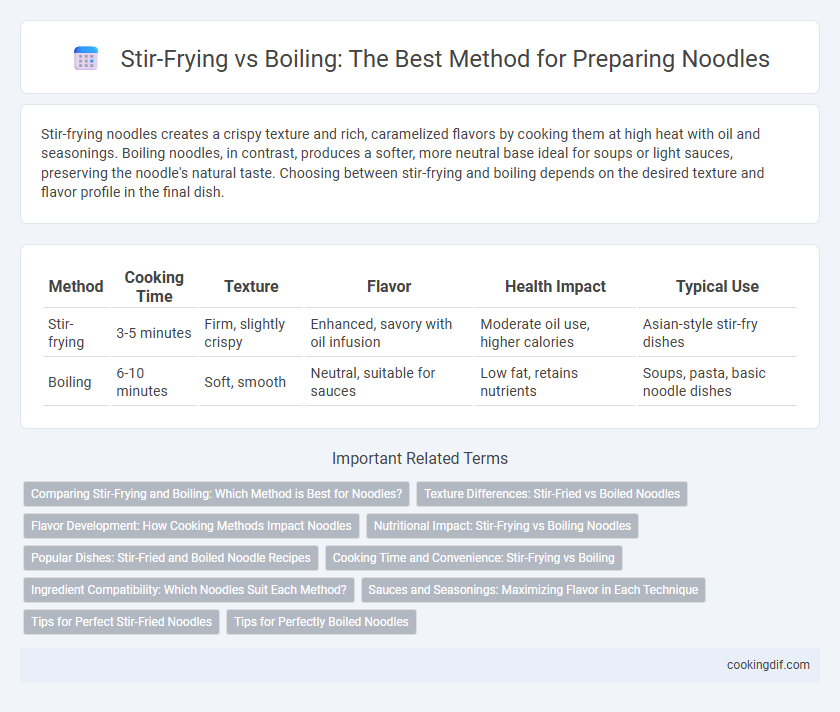Stir-frying noodles creates a crispy texture and rich, caramelized flavors by cooking them at high heat with oil and seasonings. Boiling noodles, in contrast, produces a softer, more neutral base ideal for soups or light sauces, preserving the noodle's natural taste. Choosing between stir-frying and boiling depends on the desired texture and flavor profile in the final dish.
Table of Comparison
| Method | Cooking Time | Texture | Flavor | Health Impact | Typical Use |
|---|---|---|---|---|---|
| Stir-frying | 3-5 minutes | Firm, slightly crispy | Enhanced, savory with oil infusion | Moderate oil use, higher calories | Asian-style stir-fry dishes |
| Boiling | 6-10 minutes | Soft, smooth | Neutral, suitable for sauces | Low fat, retains nutrients | Soups, pasta, basic noodle dishes |
Comparing Stir-Frying and Boiling: Which Method is Best for Noodles?
Stir-frying noodles preserves their texture and enhances flavor by quickly cooking them with high heat and minimal oil, making them ideal for dishes like chow mein and yakisoba. Boiling noodles results in a softer, more pliable texture, perfect for soups and lo mein, as it evenly cooks the noodles through water immersion. Choosing between stir-frying and boiling depends on the desired noodle texture and the specific recipe application.
Texture Differences: Stir-Fried vs Boiled Noodles
Stir-fried noodles develop a firmer, chewier texture due to high heat cooking that slightly caramelizes the surface and retains more bite. Boiled noodles absorb water, resulting in a softer, smoother consistency that is tender but less resilient. The contrast in texture is key for dishes like chow mein or pad Thai, where stir-fried noodles provide a satisfying chew compared to the gentle softness of boiled noodle soups.
Flavor Development: How Cooking Methods Impact Noodles
Stir-frying noodles intensifies flavor through caramelization and Maillard reactions, creating a rich, savory taste with a slightly crispy texture. Boiling noodles preserves their natural flavor and soft texture but often results in a bland base that relies on sauces or broths for added taste. The choice of cooking method directly influences the depth of flavor and mouthfeel, making stir-frying ideal for robust, seasoned dishes while boiling suits delicate, broth-based recipes.
Nutritional Impact: Stir-Frying vs Boiling Noodles
Stir-frying noodles retains more water-soluble vitamins like B vitamins and vitamin C compared to boiling, which often leads to nutrient loss in cooking water. The high heat in stir-frying also helps preserve protein quality and enhances flavor through Maillard reactions without significantly increasing fat content when using minimal oil. Boiling, while simpler, can reduce mineral content due to leaching, making stir-frying a nutritionally superior method for maintaining essential nutrients in noodles.
Popular Dishes: Stir-Fried and Boiled Noodle Recipes
Stir-frying noodles creates popular dishes like Pad Thai and Chow Mein, where high heat and quick cooking develop a savory, slightly caramelized flavor and a chewy texture. Boiling, essential for recipes such as Ramen and Pho, softens noodles evenly and allows them to absorb broths infused with rich spices and umami. Both methods highlight regional ingredients, with stir-fried dishes favoring crisp vegetables and sauces, while boiled noodles complement fragrant, flavorful soups.
Cooking Time and Convenience: Stir-Frying vs Boiling
Stir-frying noodles typically requires less cooking time, around 5-7 minutes, making it a quick and convenient method for a flavorful meal. Boiling noodles usually takes 8-12 minutes depending on the noodle type, offering a straightforward approach ideal for batch preparation. Stir-frying requires pre-cooked noodles and additional ingredients, while boiling is simpler but may need extra time for draining and seasoning.
Ingredient Compatibility: Which Noodles Suit Each Method?
Stir-frying pairs best with firmer noodles like udon, lo mein, and rice noodles, as their sturdy texture holds up well under high heat and tossing with vegetables and sauces. For boiling, delicate noodles such as thin egg noodles, soba, and rice vermicelli are ideal because they cook quickly and evenly in water without becoming mushy. Selecting the right noodle based on texture and cooking method enhances ingredient compatibility and ensures optimal flavor and consistency.
Sauces and Seasonings: Maximizing Flavor in Each Technique
Stir-frying noodles allows sauces and seasonings to coat each strand evenly, creating a rich, concentrated flavor profile as the high heat caramelizes ingredients and intensifies aromas. Boiling noodles, by contrast, softens the texture and extracts starch, which can dilute sauces but provides a neutral base that highlights the essence of light, broth-based seasonings. Balancing the choice of sauces--thick, savory for stir-fry and subtle, clear for boiling--maximizes flavor impact in each cooking technique.
Tips for Perfect Stir-Fried Noodles
For perfect stir-fried noodles, ensure the noodles are slightly undercooked by boiling them for 1-2 minutes less than package instructions to maintain firmness. Use high heat and a wok to quickly sear ingredients, preventing sogginess and enhancing flavor through caramelization. Incorporate a balance of soy sauce, oyster sauce, and sesame oil for authentic taste and toss noodles consistently for even cooking and coating.
Tips for Perfectly Boiled Noodles
For perfectly boiled noodles, use plenty of water to prevent sticking and maintain even cooking. Add salt to the boiling water to enhance flavor and achieve the ideal texture. Stir noodles occasionally during boiling to keep them separate and monitor cooking time closely to avoid overcooking or mushiness.
Stir-frying vs boiling for noodle preparation Infographic

 cookingdif.com
cookingdif.com